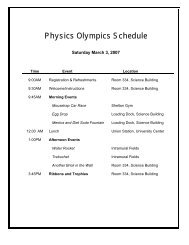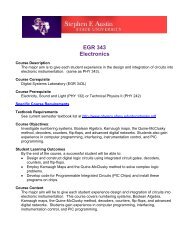Program - Physics & Astronomy - Stephen F. Austin State University
Program - Physics & Astronomy - Stephen F. Austin State University
Program - Physics & Astronomy - Stephen F. Austin State University
Create successful ePaper yourself
Turn your PDF publications into a flip-book with our unique Google optimized e-Paper software.
3:06 pm - SPS-9 - Study of Effects of the Heat Treat Time onthe Crystal Structure of the Copper-Sheathed MgB 2Superconducting Wires , D. Katz, S. Keith, and G. Liang, SamHouston <strong>State</strong> <strong>University</strong>, stddak11@shsu.edu,phy_gnl@unx1.shsu.edu. The recently discovered MgB 2superconductor is very promising for future large-scaleapplications. In this presentation, we report the X-ray diffractionmeasurement result for a series of copper sheathed MgB 2 wireswhich were heat treated at 725 °C for different times: 1, 3, 5, 7,10, and 30 minutes. We have the following two amazingfindings: (1) the superconducting MgB 2 phase can be formedwith a heat treat time as short as 3 minutes; (2) the impurityMg 1+y Cu 32 ¬+? phase is only seen in the sample heat treated for 5minutes, not for other samples. These findings will be veryuseful for fabrication of MgB 2 wires with high current density.3:42 pm - SPS-10 - Synthesis of Ozone from TitaniumDioxide, Daniel Backlund, Angelo <strong>State</strong> <strong>University</strong>,dbacklund@yahoo.com. It is known that ozone can besynthesized from the direct exposure of ultraviolet light to thesurface of titanium dioxide (Kittel). The goal of our research isto see what frequencies and energies of ultraviolet light can beused to produce amounts of ozone sufficient for sterilizationprocedures from a titanium dioxide sample surface. The titaniumdioxide samples were enclosed in a sealed chamber outfittedwith pressure and temperature monitors that allowed fordetection of gases produced by the ozone reaction. Spectralanalysis of light sources, along with optical power calculationswas performed. Preliminary results indicate that production ofozone using this process is minimal3:54 pm - SPS-11 - Investigation of a Novel ProductionMethod to Fabricate Porous Silicon, A. N. Robason, T.D.Sauncy, Angelo <strong>State</strong> <strong>University</strong>,andrea_robason@hotmail.com. Porous silicon thin films are ofcurrent interest due to their potential in silicon-basedoptoelectronic devices. Crystalline silicon samples have beenchemically etched while illuminated by a helium-neon laser.According to published reports, this sample processingtechnique results in a thin matrix of voids on the surface of thecrystal. Several processing parameters have been studied inorder to find an optimal method for the contactless production ofporous silicon thin films. Thus far, the techniques have shownminimal success. After processing, the samples are characterizedusing optical spectroscopy and electrical measurements todetermine variations in the electronic properties with processing.The successes and limitations of the process will be discussed.4:06 pm - SPS-12 - A "Sabre Saw" Electric Generator, J. D.Campbell, Gregory Coutant, Jeffrey Lewis, Wilson Tenney, andKen Taylor, Lake Highlands High School, ken.taylor@risd.org.A sabre saw with permanent magnets mounted to a pseudo bladeis used to induce an emf in a variety of coil configurations. Theoutput power, and other characteristics of the electric generatorformed by this interesting combination, are described. Theresults of this research project can be used as a guide indeveloping demonstrations that introduce students to the ideas ofelectromagnetic induction.4:18 pm - SPS-13 - Magnetically Driven Mass-SpringOscillations, Craig M. Birch, Kevin J. Brown, Stephanie A.30Brown, Mia Ovcina, Ken Taylor, Lake Highlands High School,ken.taylor@risd.org. This paper describes the behavior of amass-spring system when excited by the attractive magneticforce between its turns when a current is flowing through thespring. Techniques for introducing and controlling the currentare presented. In addition, damping of the oscillator and itsresonance response to the driving force are discussed. Thisexperiment can be used for demonstration purposes or as alaboratory experiment in introductory physics.4:30 pm - SPS-14 - Hydroelectric Energy, Yvette Bass,<strong>Stephen</strong> F. <strong>Austin</strong> <strong>State</strong> <strong>University</strong>, ymb518@aol.com. TheHoover dam operation and construction.4:42 pm - SPS-15 - Magnetic Levitation, Jefferson Jackson,<strong>Stephen</strong> F. <strong>Austin</strong> <strong>State</strong> <strong>University</strong>, roadkilljack@aol.com.Magnetic Levitation of trains.Poster Session2:30 - 4:00 pmAC-1 - The Power of Inverse Adding-Doubling (IAD)Method to Determine Optical Scattering and Absorption ofBiological Media, Guang-Yin Swanland, Raylon Yow, DhirajSarda. The IAD method is a numerical approach to determinethe optical properties of biological tissue samples by using themeasurements of total diffuse reflectance and total diffusetransmittance in conjunction with the index of refraction and thethickness of a homogeneous slab of turbid medial. It can be usedon slabs within or without slide glass, including slabssurrounded by a medium with a different index of refraction.The turbid slabs can have any optical thickness, albedo, or phasefunction. The IAD method obtains the optical properties of theslab by repeatedly using an adding-doubling method to solve theradiative transport equation until those derived properties are theclosest match to the measured values. The IAD method has theadvantages of accuracy and flexibility in regard to the sample.AC-2 - Electron Microscopic Studies of the Charge-OrderedStructures of the Bilayered Colossal Magnetoresistive(CMR) Manganite La 2-2x Sr 1+2x Mn 2 O 7 , Zhiping Luo,Microscopy and Imaging Center, Texas A&M <strong>University</strong>,luo@mic.tamu.edu. The charge-ordered structures in thebilayered colossal magnetoresistive (CMR) manganiteLa 2-2x Sr 1+2x Mn 2 O 7 at the electronic doping levels of x = 0.6 andx = 0.67 respectively, have been proposed based on the in-situelectron microscopic studies. In sharp contrast to the threedimensionalperovskite manganite, evidence of charge-orderedstructures with bi-stripe models has been found. A new facecenteredcharge-ordered superstructure was observed at x = 0.6.This structure is composed of bi-stripes of Mn 3+ O 6 and pairedMn 4+ O 6 rows alternatively stacking along the ordering direction,which is assembled from the building blocks of the chargeorderedphase at x = 0.5. Taking into account of the systematicabsence of reflections with the face-centered symmetry, itsmodulation vector was deduced as q = (1/10, 1/10, 0). Moreover,for another charge-ordered phase identified at x = 0.67 withq = (1/6, 1/6, 0), again only the bi-stripe model fits the existingdata over the Wigner-crystal model.




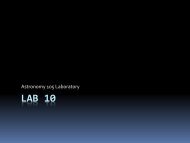
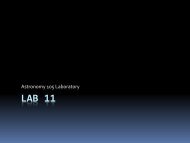
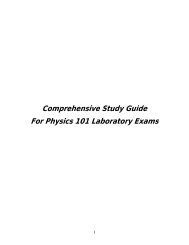

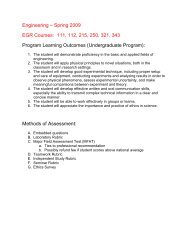
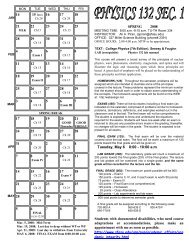
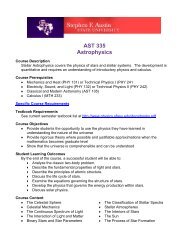

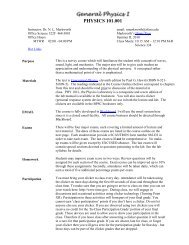
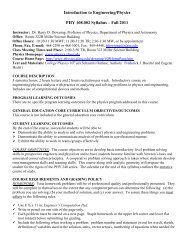
![[pdf] physics 110 fundamentals of electronics](https://img.yumpu.com/29312006/1/190x245/pdf-physics-110-fundamentals-of-electronics.jpg?quality=85)
